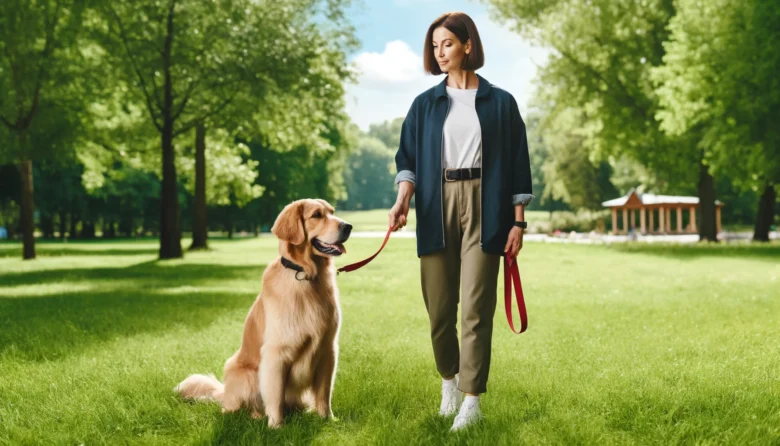Controlling your dog on a leash is an important skill that every dog owner should have. It ensures that walking is safe and fun. Not only do you want to prevent your dog from escaping, but you also want to build a kind and understanding relationship with your furry friend. This article discusses five important tips that can change the way you walk your dog. It emphasizes the importance of choosing the right line, training concentration, mastering heel control, controlling pull, being patient and practicing regularly.
Tip 1: Choose the Right Leash
Choosing the right leash for your dog is the first thing you need to do to handle it properly. There are many different types of leashes on the market, from standard nylon leashes to retractable leashes and even training leashes. It is important to find one that offers both comfort and freedom. For example, a sturdy, fixed-length leather collar can be easier to control and last longer, especially for larger dogs that like to pull. On the other hand, a lightweight, retractable leash may be best for small, well-behaved dogs taken for a leisurely walk. When choosing a leash, consider how your dog behaves, how big he is and where you will be walking him.
Tip 2: Improve Concentration
It is much easier to control a dog that is close to people. It is important to teach your dog to focus on you and not on other things. To avoid distractions, start this session in a quiet place. Use treats or toys as a reward and tell your dog “look at me” or “focus” to get and keep his attention. Gradually add more distractions over time to ensure your dog stays focused, even in a busy park or on the street. This training ensures that your dog remains alert to your commands and presence, making it easier for you to control your dog on a leash.
Tip 3: Learn How to Use the Trace Command
It’s fun to walk with a dog that knows how to lead and execute. With this command, you teach your dog to walk calmly next to you, instead of in front of or behind you. Start in a quiet place and use treats to get your dog to sit next to you correctly. When your dog stays put, tell him to go ahead and give him a treat. As you get better at exercising, add more distractions and lengthen the walk. Not only will this command help you gain better control of the leash, it will also solidify your position as pack leader and ensure that your dog respects and follows your lead.
Tip 4: Deal with the Behavior That Attracts You
Many dog owners have difficulty pulling their dogs on a leash. It’s important to understand why your dog pulls, whether he’s excited, scared or just wants to explore. Using positive reinforcement can help you control this behavior. If your dog starts pulling, stop walking. Do not proceed until your dog is calm and off leash. It is important to be consistent; this teaches your dog that pulling keeps him from spotting, rather than making him move faster. Your dog will eventually learn that the best and most fun way to explore is to walk quietly next to you.
Tip 5: Practice Often and Be Patient
Like any other skill, line control improves with practice. Make time every day to train your dog in walking and obedience. As his skills improved, the exercises became more difficult and lasted longer. Remember, waiting is the key. Some dogs may take longer to learn, especially if they already know how to do something. Make sure you maintain a positive, supportive mood throughout your training and enjoy the small victories.
Conclusion:
Keeping your dog under control on a leash is an important part of dog ownership and can make walks more enjoyable for both of you. If you choose the right leash, teach your dog to concentrate, learn the heel command, deal with pulling problems, exercise regularly and are patient, you and your dog can enjoy a nice walk together. Remember that every dog is different, so what works for one dog may not work for another. For best results, make sure your method is appropriate for your dog’s needs and personality.
FAQs:
1. What should I do if my dog keeps pulling on the leash even though I have taught him not to?
If your dog still pulls on the leash after training, you can try a no-pull harness or seek help from a professional dog trainer. If the pulling behavior does not go away, a different approach or more targeted training is sometimes necessary.
2. Will using different types of leashes on the same dog cause confusion or make leash training more difficult?
It can be confusing to use different types of leashes for the same dog, especially if the leash gives you different levels of control and freedom. For clear and regular communication, it is best to always use the same type of belt during training.
3. It appears that the dog is afraid or unwilling to be walked on a leash. How can I train him to adapt to it?
If your dog is afraid or doesn’t want to use a leash, let him get used to the leash first without wearing it at all. To get your dog to like the leash, keep your dog close to him while you play and give him treats. Put the leash on slowly for short periods of time, and provide treats and rewards to help the dog get used to it and trust it.
4. Should leash training start in a quiet place or a busy place?
When you first start leash training, it is best to do it in a quiet place with few distractions. This allows your dog to focus on you and the direction you are teaching him. If you want to continue training your dog in different locations, you can slowly add more distractions as he recovers.
5. How long does it typically take to gain tape control proficiency over time?
How long it takes to learn to walk on a leash depends on the dog’s age, personality, and the level of previous training it has received. With regular daily training, most dogs can improve their ability to walk on a leash within a few weeks to a few months.


